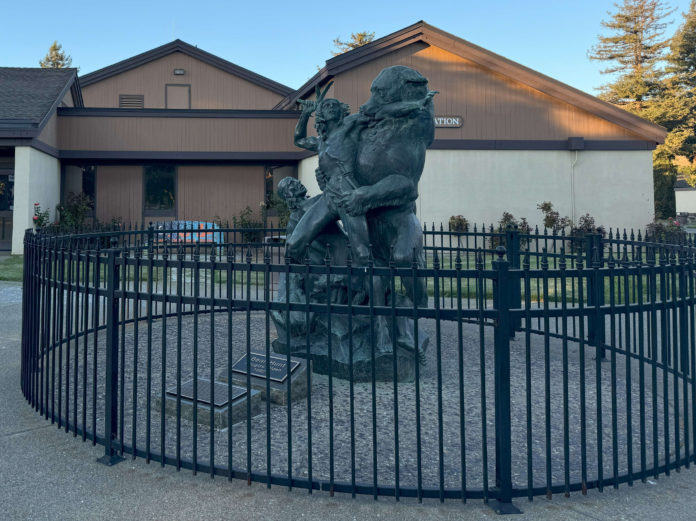Naomi Caselli, a Boston University associate professor of deaf education, researches the impact of early exposure to American Sign Language (ASL), and says there’s a critical window in the first few years of life where access to language is most critical.
“If we don’t get access to language during that critical period, it wreaks havoc,” Caselli said.
In July, Caselli conducted an empirical study on CSD learning outcomes. She sought to find disparities in educational achievement between deaf children with deaf caregivers, who are more likely to be “linguistically enriched,” and deaf children with hearing/non-signing parents, who are considered to be at high risk for language deprivation. Her hypothesis was that if early immersion in a bilingual (ASL and English) education environment promotes ASL proficiency among deaf students with hearing caregivers, their ASL scores should overlap entirely with deaf children who have deaf caregivers.
Comparing them against a Reference Group of deaf students with deaf caregivers, Caselli analyzed ASL test scores of 20 “Early Entry” students, defined as students who entered CSD by age three, and 406 “Late Entry” ones who enrolled after that age. While students in the Early Entry category began with lower ASL scores than their peers in the Reference Group, their scores completely overlapped by around fourth grade, and the overlap persisted through high school. Conversely, Late Entry students on average scored much lower than their Early Entry peers, a disadvantage that persisted into high school.
The same disparities were found when testing both groups of students in math, reading, science, and writing, showing that early access to English-ASL bilingual education was linked to not only better acquisition of language, but better academic outcomes overall. In recent years, disability advocacy groups like the Individuals with Disabilities Education Act (IDEA) have pushed back on special schools, believing mainstream integration to be more inclusive than segregation. Caselli argues that while this is often true for students with other conditions, it has the opposite effect for deaf students, often leaving them isolated as their condition directly impacts communication. For deaf students, inclusion means having peers you can socialize with, and deaf schools offer just that.
“We best learn language in community with our peers,” Caselli said. “That’s where the magic happens.”
In Caselli’s study, 95% of students were considered “Late Entry” into CSD, which she said could suggest that parents send their students there as a last-ditch effort when the mainstream approach is not working. Deaf schools as a last resort could be due to the audist stigma that they provide an inferior education: a myth that CSD’s ASL teacher Ty Kovacs has been set out to squash.
While ongoing staffing shortages could have serious implications for the quality of education at CSD, Kovacs has been a beacon of hope. For more than a decade, he has been on the front lines advocating for the school through the Service Employees International Union (SEIU Local 1000). He has lifelong ties to CSD, beginning as a student. He returned to CSD for his first role as a counselor and has been fighting for better wages ever since.
“The situation has only worsened,” said Kovacs, reflecting on his long history of organizing.
With Kovacs as their steward, the school has made small strides in improving the state of deaf education. In 2000 he was a part of the Save Our School committee, where he presented the same cost of living concerns they face today to state officials. In November, a proposal to increase CSD’s visibility by allowing for the installation of highway signs was adopted by Governor Gavin Newsom.
But with no real progress on wage negotiations, Kovacs is exploring new potential ways forward, including a relocation of the campus to a cheaper city, housing assistance for staff and families, and staff property tax waivers. No plan is set in stone yet, but Kovacs has been adamant about hosting community gatherings for CSD staff, parents and alumni to weigh in on next steps.
With just three to five years before he retires, Kovacs is turning up the heat as he demands action from senators, assembly members and other local leaders. Looking back, he’s saddened to know the school could be on a different trajectory if the state had responded to their initial calls 30 years ago. But the same resiliency that carried him through decades of advocacy hasn’t faded yet. And so, he continues to fight.
“I just want to retire knowing that CSD will be okay,” he said.
Superintendent Tony Thurmond did not respond to multiple requests for an interview.
UPDATE: Read the Jan. 22 response from California State Superintendent of Public Instruction Tony Thurmond here.
For Part I, visit tricityvoice.com/deaf-community-fights-for-education-part-1/





The fact that the schools were understaffed and that the teachers were also underpaid is overwhelming to think about. It’s great how, despite the pay not being enough, teachers still wanted to help deaf kids socialize and prevent segregation. It’s awesome how hard people are working to help the deaf community.